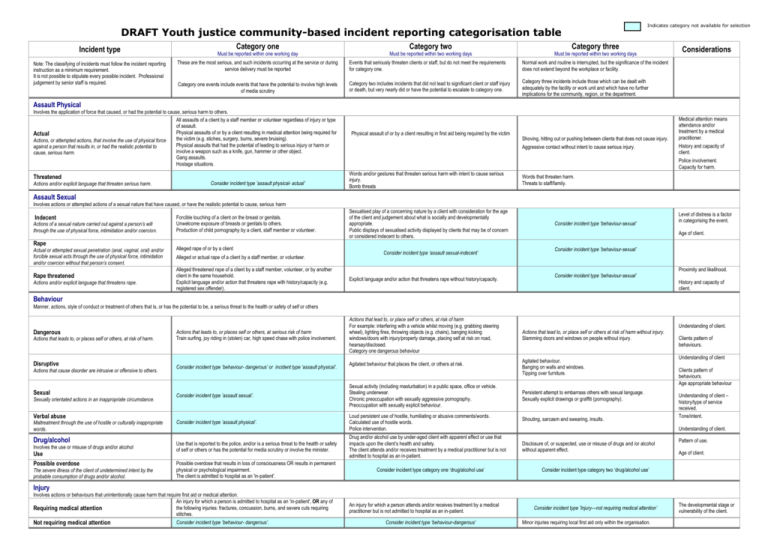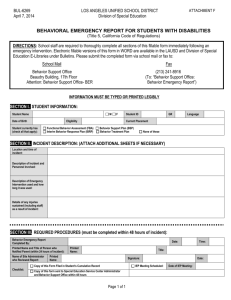
Indicates category not available for selection
DRAFT Youth justice community-based incident reporting categorisation table
Incident type
Note: The classifying of incidents must follow the incident reporting
instruction as a minimum requirement.
It is not possible to stipulate every possible incident. Professional
judgement by senior staff is required.
Category one
Must be reported within one working day
Category two
Must be reported within two working days
Category three
Must be reported within two working days
These are the most serious, and such incidents occurring at the service or during
service delivery must be reported
Events that seriously threaten clients or staff, but do not meet the requirements
for category one.
Normal work and routine is interrupted, but the significance of the incident
does not extend beyond the workplace or facility.
Category one events include events that have the potential to involve high levels
of media scrutiny
Category two includes incidents that did not lead to significant client or staff injury
or death, but very nearly did or have the potential to escalate to category one.
Category three incidents include those which can be dealt with
adequately by the facility or work unit and which have no further
implications for the community, region, or the department.
Considerations
Assault Physical
Involves the application of force that caused, or had the potential to cause, serious harm to others.
All assaults of a client by a staff member or volunteer regardless of injury or type
of assault.
Physical assaults of or by a client resulting in medical attention being required for
Actual
the victim (e.g. stiches, surgery, burns, severe bruising).
Actions, or attempted actions, that involve the use of physical force
Physical assaults that had the potential of leading to serious injury or harm or
against a person that results in, or had the realistic potential to
involve a weapon such as a knife, gun, hammer or other object.
cause, serious harm.
Gang assaults.
Hostage situations.
Threatened
Actions and/or explicit language that threaten serious harm.
Consider incident type ’assault physical- actual’
Physical assault of or by a client resulting in first aid being required by the victim
Shoving, hitting out or pushing between clients that does not cause injury.
Aggressive contact without intent to cause serious injury.
Medical attention means
attendance and/or
treatment by a medical
practitioner.
History and capacity of
client.
Police involvement.
Capacity for harm.
Words and/or gestures that threaten serious harm with intent to cause serious
injury.
Bomb threats
Words that threaten harm.
Threats to staff/family.
Assault Sexual
Involves actions or attempted actions of a sexual nature that have caused, or have the realistic potential to cause, serious harm
Indecent
Actions of a sexual nature carried out against a person’s will
through the use of physical force, intimidation and/or coercion.
Rape
Actual or attempted sexual penetration (anal, vaginal, oral) and/or
forcible sexual acts through the use of physical force, intimidation
and/or coercion without that person’s consent.
Rape threatened
Actions and/or explicit language that threatens rape.
Forcible touching of a client on the breast or genitals.
Unwelcome exposure of breasts or genitals to others.
Production of child pornography by a client, staff member or volunteer.
Alleged rape of or by a client
Alleged or actual rape of a client by a staff member, or volunteer.
Alleged threatened rape of a client by a staff member, volunteer, or by another
client in the same household.
Explicit language and/or action that threatens rape with history/capacity (e.g.
registered sex offender).
Sexualised play of a concerning nature by a client with consideration for the age
of the client and judgement about what is socially and developmentally
appropriate.
Public displays of sexualised activity displayed by clients that may be of concern
or considered indecent to others.
Consider incident type ‘assault sexual-indecent’
Explicit language and/or action that threatens rape without history/capacity.
Consider incident type ‘behaviour-sexual’
Level of distress is a factor
in categorising the event.
Age of client.
Consider incident type ’behaviour-sexual’
Consider incident type ’behaviour-sexual’
Proximity and likelihood.
History and capacity of
client.
Behaviour
Manner, actions, style of conduct or treatment of others that is, or has the potential to be, a serious threat to the health or safety of self or others
Dangerous
Actions that leads to, or places self or others, at risk of harm.
Actions that leads to, or places self or others, at serious risk of harm
Train surfing, joy riding in (stolen) car, high speed chase with police involvement.
Disruptive
Consider incident type ’behaviour- dangerous’ or incident type ‘assault physical’.
Actions that cause disorder are intrusive or offensive to others.
Sexual
Sexually orientated actions in an inappropriate circumstance.
Verbal abuse
Maltreatment through the use of hostile or culturally inappropriate
words.
Drug/alcohol
Involves the use or misuse of drugs and/or alcohol
Use
Possible overdose
The severe illness of the client of undetermined intent by the
probable consumption of drugs and/or alcohol.
.
Actions that lead to, or place self or others, at risk of harm
For example: interfering with a vehicle whilst moving (e.g. grabbing steering
wheel), lighting fires, throwing objects (e.g. chairs), banging kicking
windows/doors with injury/property damage, placing self at risk on road,
hearsay/disclosed.
Category one dangerous behaviour
Agitated behaviour that places the client, or others at risk.
Consider incident type ’assault sexual’.
Sexual activity (including masturbation) in a public space, office or vehicle.
Stealing underwear.
Chronic preoccupation with sexually aggressive pornography.
Preoccupation with sexually explicit behaviour.
Consider incident type ’assault physical’.
Loud persistent use of hostile, humiliating or abusive comments/words.
Calculated use of hostile words.
Police intervention.
Use that is reported to the police, and/or is a serious threat to the health or safety
of self or others or has the potential for media scrutiny or involve the minister.
Drug and/or alcohol use by under-aged client with apparent effect or use that
impacts upon the client’s health and safety.
The client attends and/or receives treatment by a medical practitioner but is not
admitted to hospital as an in-patient.
Possible overdose that results in loss of consciousness OR results in permanent
physical or psychological impairment.
The client is admitted to hospital as an 'in-patient'.
Consider incident type category one ‘drug/alcohol use’
Actions that lead to, or place self or others at risk of harm without injury.
Slamming doors and windows on people without injury.
Agitated behaviour.
Banging on walls and windows.
Tipping over furniture.
Persistent attempt to embarrass others with sexual language.
Sexually explicit drawings or graffiti (pornography).
Shouting, sarcasm and swearing, insults.
Understanding of client.
Clients pattern of
behaviours.
Understanding of client
Clients pattern of
behaviours.
Age appropriate behaviour
Understanding of client –
history/type of service
received.
Tone/intent.
Understanding of client.
Disclosure of, or suspected, use or misuse of drugs and /or alcohol
without apparent effect.
Pattern of use.
Age of client.
Consider incident type category two ‘drug/alcohol use’
Injury
Involves actions or behaviours that unintentionally cause harm that require first aid or medical attention.
An injury for which a person is admitted to hospital as an 'in-patient', OR any of
the following injuries: fractures, concussion, burns, and severe cuts requiring
Requiring medical attention
stitches.
Not requiring medical attention
Consider incident type ’behaviour- dangerous’.
An injury for which a person attends and/or receives treatment by a medical
practitioner but is not admitted to hospital as an in-patient.
Consider incident type ‘behaviour-dangerous’
Consider incident type ’Injury—not requiring medical attention’
Minor injuries requiring local first aid only within the organisation.
The developmental stage or
vulnerability of the client.









